|
|
参考网站 http://docs.python.org
Ipython最新版本IPython2.1.0
http://ipython.org/
Ipython的安装(摘自samoobook)
废话一句,ipython是python shell的增强版,支持语法高亮,1.2.0不再需要pyreadline模块。
基本软件:python3.3.4,、pypa-setuptools、ipython1.2.0
1、安装python3.3.4,一路next,不述。默认路径为 C:\Python33
2、首先安装setuptools,因为ipython安装时会首先调用该模块:
cmd下cd到setuptools目录下,执行python setup.py install
完成后,cd到ipython的目录下,执行python setup.py install
3、设置ipython的环境变量,在path内加入C:\Python33\Scripts,一直确定,退出。
4、特别注意,重新打开cmd,输入ipython,然后回车会报错,这是为什么呢?
打开C:\Python33\Scripts会发现,ipython的程序名是ipython3.exe。所以
C:\>ipython3
Python 3.3.4 (v3.3.4:7ff62415e426, Feb 10 2014, 18:12:08) [MSC v.1600 32 bit (In
tel)]
Type "copyright", "credits" or "license" for more information.
IPython 1.2.0 -- An enhanced Interactive Python.
? -> Introduction and overview of IPython's features.
%quickref -> Quick reference.
help -> Python's own help system.
object? -> Details about 'object', use 'object??' for extra details.
1.1 利用缩进格式组织代码
python是用缩进来组织代码的.
for x in array:
if x < pivot:
less.append(x)
else:
greater.append(x)
一般利用4个空格进行缩进.
1.2 变量和按引用传递
在Python中对变量赋值时,你其实是在创建等号右侧对象的一个引用。
a = [1,2,3]
b = a
a.append(4)
此时b的值为[1,2,3,4]
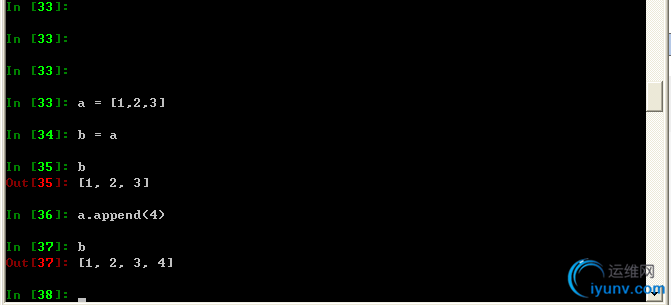
1.3 动态和强类型
a= 5
isinstance(a,int)
True
a=[1,2,3]
isinstance(a,list)
True
a=(1,2,3)
isinstance(a,tuple)
True
1.4 属性和方法
a = "foo"
a.<tab>
将会列出a的所有属性和方法.
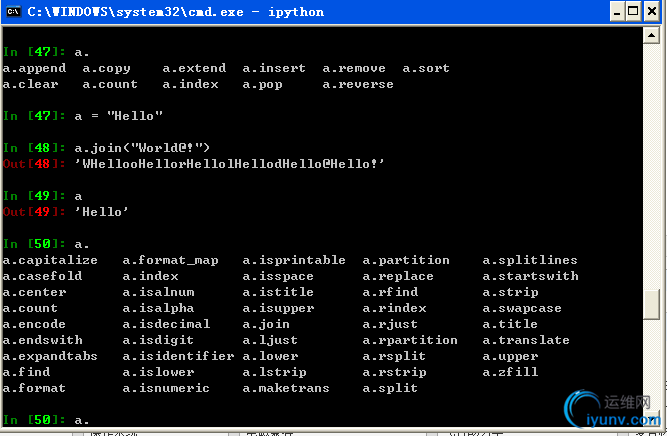
1.5 判断某些类型是否可以迭代
def isiteralbe(obj):
try:
iter(obj)
return True
expect TypeError:
return false
1.6 判断两个引用是否指向同一个对象
a = [1,2,3]
b = a
a is b
True
a is not c
True
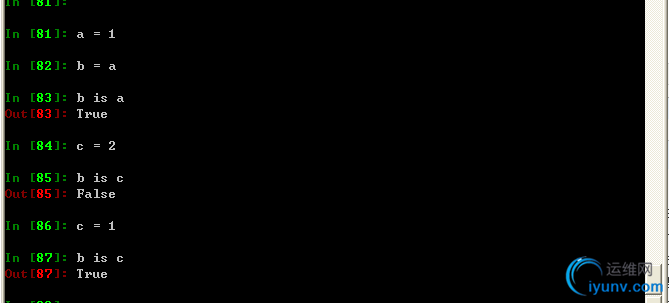
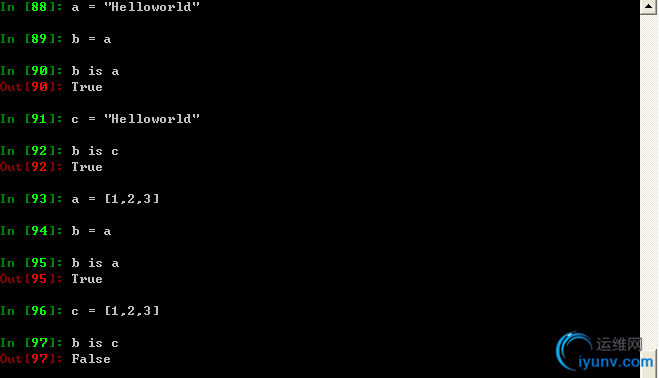

内置数据类型,字符串和元组及列表不同-----此问题待进一步分析 ?
1.7 严格与懒惰(待补充)
1.8可变和不可变对象
大部分Python对象是可变的,比如列表,字典,Numpy数组以及用户自定义类型,也就是说它们所包含的对象和值是可以改变的。而其他的(字符串和元组)则是不可变的,意即不能修改原内存块的数据,也只是创建了一个新对象并将其引用赋值给原变量而已。
1.9标量类型
None
str
unicode
float
bool
int
long
1.10 元组拆包
普通元组拆包
tup = (4,5,6)
a,b,c = tup
b
5
嵌套元组拆包
tup = 4,5,(6,7)
a,b,(c,d) = tup
d
7
交换变量
a = 1
b =2
b,a = a,b
元组方法
a = (1,2,3,3,3,3)
a.count(3)
4
1.10 列表
a_list = [1,2,3,4]
tup = ("Tom","Marry","Jack")
b_list = list(tup)
b_list[1] = "ren"
b_list.append("Hawk")
b_list.insert(1,red) #在第1个位置将red插入,则red的序号变为1
b_list.pop(2) #弹出第2个位置上的元素.
b_list.remove("Marry") #按值删除
通过in关键字判断列表中是否含有某值.
"Hawk" in b_list
注意:判断列表是否含有某个值的操作比字典(dict)和集合(set)慢得多,因为Python会对列表中的值进行线形扫描,而另外两个(基于哈希表)则可以瞬间完成.
合并列表
方式一:[4,None,"foo"]+[7,8,(2,3)]
方式二:x =[4,None,"foo"]
x.extend([7,8,(2,3)])
方式二的效率要快于方式一
排序
a = [1,2,3,5,6]
a.sort()
二分搜索及维护有序列表
import bisect
c = [1,2,2,2,3,4,7]
bisect.bisect(c,2) # bisect.bisect()决定新元素应该被插入到哪个位置才能保证原列表的有序性,而bisect.insort()则确实将元素插入到那个位置。
切片
seq[:stop] seq[start:] seq[star:stop] sep[::step]
内置的序列函数
enumerate
some_list = ["foo","bat","baz"]
mapping = dict((v,i) for i,v in enumerate(some_list))
mapping
["bat":1,"baz":2,"foo":0]
sorted
sorted([7.1,3,6,8,9])
[1,3,6,7,8,9]
zip
seq1 = ["foo","bar","baz"]
seq2 = ["one","two","three"]
zip(seq1,seq2)
[("foo","one"),("bar","two"),("baz","three")]
dict
empty_dict={}
empty_dict={"name":"shihanbing","gainder":"male","age":40}
empty_dict.update({"career":"software engineer"})
del empty_dict["name"]
temp = empty_dict.pop("gainder")
mapping={}
key_list = [1,2,3,4]
value_list = ["Maozedong","zhude","zhouenlai","dongbiwu"]
for key,value in zip(key_list,value_list):
mapping[key] = value
default
some_dict = {"port":"com1","baudrate":15200,"stop":1,"databit":8}
value = some_dict.get("port","the key is valid!please enter the correct key")
value = some_dict.get("parity","the key is valid!please enter the correct key")
words =["apple","pear","peach","berry","banana","pineapple","nut","watermellon"]
by_letter = {}
letter =""
for word in words:
letter = word[0]
if letter not in by_letter:
by_letter[letter] = [word]
else:
by_letter[letter].append(word)

可以用一句话代替if ... else ...
by_letter.setdefault(letter,[]).append(word)
更简单的写法:
from collections import defaultdict
words =["apple","pear","peach","berry","banana","pineapple","nut","watermellon"]
by_letter = defaultdict(list)
for word in words:
by_letter[word[0]].append(word)
字典键的有效类型
键必须是不可变对象,具有哈希性。列表不可以作为键,如果要将列表当做键,最好的方法是将其转换成元组。
d={}
d[tuple([1,2,3])] = 5
集合
s1 = set([2,2,3,5,6,7,8])
s2 = {2,4,5,6,7,9}
| 集合并运算
&集合交运算
-集合差运算
^集合异或运算
s1.issuperset(s2) 判断s1是否是s2的超集
列表、集合及字典的推导式
[expr for val in collection if condition]
嵌套列表推导式
all_data = [["Tom","Billy","Jefferson","Andrew","Wesley","Steven","Joe"],["Susie","Caseu","jill","Ana","Eva","Jennifer","Stephanie"]]
names_of_intrest = []
for names in all_data:
enough_es = [name for name in names if name.count("e") > 2]
names_of_intrest.extend(enough_es)
函数亦对象
states = [' Alabama','Georgia!','Georgia','georgia','Fl0rIda','south carolina##','West virginia?']
def remove_punctuation(value):
return re.sub('[!#?]','',value)
clear_ops = [str.strip,remove_punctuation,str.title]
def clean_strings(strings,ops):
result = []
for value in strings:
for funciton in ops:
value = funciton(value)
result.append(value)
return result
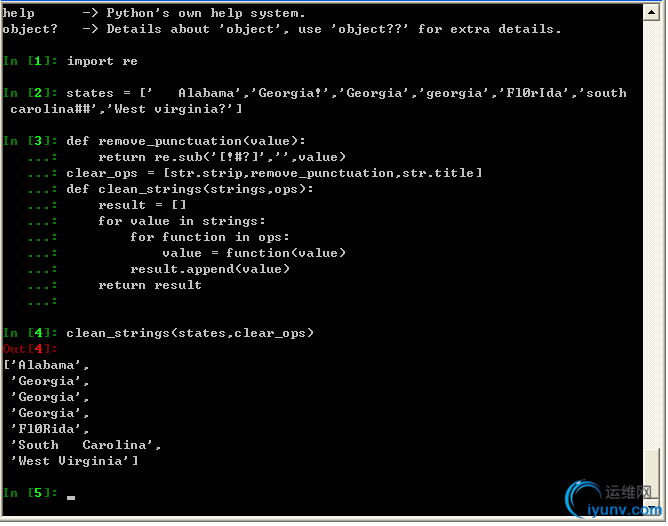
匿名函数(Lambda)
def apply_to_list(some_list,f):
return [f(x) for x in some_list]
ints = [4,0,1,5,6]
apply_to_list(ints,lambda x:x*2)
闭包:返回函数的函数
闭包就是由其他函数动态生成并返回的函数,其关键性质是,被返回的函数可以访问其创建者的局部命名空间中的变量。闭包和标准Python函数之间的区别在于:即使其创建者
已经执行完毕,闭包仍能访问其创建者的局部命名空间.
def make_closrue(a):
def closure():
print("I know the secret : %d" %a)
return closure
my_closure = make_closure(6)
my_closure() # 当执行完这一句后将打印如下信息
I know the secret :6
在闭包中使用可变对象(如字典、集合和列表等)
def make_watcher():
have_seen = {}
def has_been_seen(x):
if x in have_seen:
return True
else:
have_seen[x] = True
return False
return has_been_seen
watcher = make_watcher()
vals = [5,6,1,5,1,6,3,5]
[watcher(x) for x in vals]
[False,False,False,True,True,True,False,True]
创建一个始终返回15位字符串的浮点数格式化器《
def format_and_pad(template,space):
def formatter(x):
return (template % x).rjust(space)
return formatter
fmt = format_and_pad("%.4f",15)
fmt(1.756)
' 1.756'
扩展调用语法和 *args ,**kwargs
当你编写函数func(a,b,c,d=some,e=value)时,位置和关键字其实被打包成元组和字典的,函数实际接收到的是一个元组args和一个字典kwargs,
def say_hello_then_call_f(f,*args,**kwargs):
print "args is",args
print "kwargs is", kwargs
print("Hello! Now I'm going to call %s" % f)
return f(*args,**kwargs)
def g(x,y,z=1)
return (x + y) /z
say_hello_then_call_f(g,1,2,z=5)
args is (1,2)
kwargs is {'z':5.0}
Now I am going to call{function g at 0x2dd5cf8}
生成器
生成器是构造新的可迭代对象的一种简单方式。一般的函数执行之后只会返回单个值,而生成器则是以延迟的方式返回一个值序列,将函数的return 改为yield,将会创建一个生成器。
def square(n=10):
print "Generating squares from 1 to %d" % (n ** 2)
for i in xrange(1,n+1):
yield i**2
生成器表达式
生成器表达式是构造生成器的最简单方式。
gen = (x**2 for x in xrange(100))
sum (x**2 for x in xrange(100))
dict((i,i **2) for i in xrange(5))
intertools模块
|
|